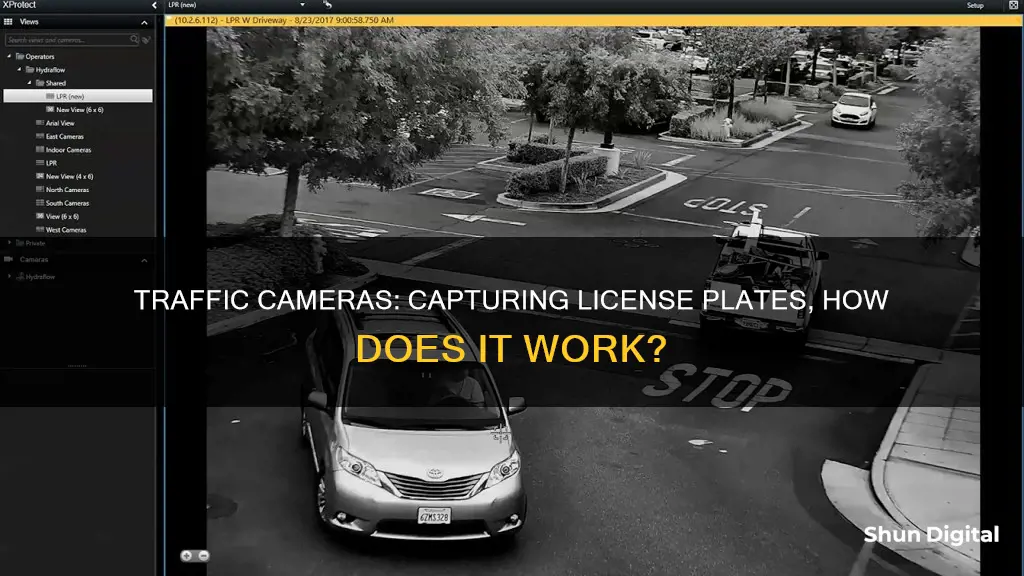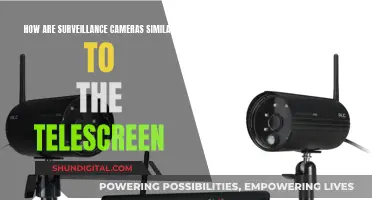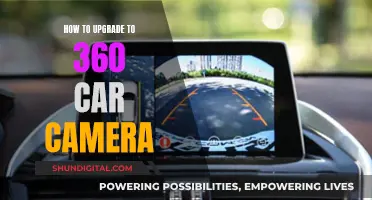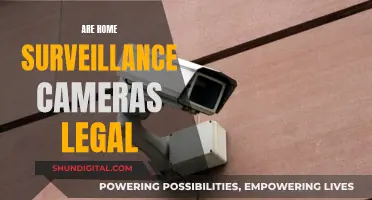
Traffic cameras that capture license plates are called license plate recognition (LPR) cameras. They are advanced traffic sensors that can capture and digitalize images from license plates in real time and with high precision. LPR cameras are equipped with special hardware and firmware that enable them to instantly recognize, capture, and analyze license plate images, going beyond regular optical character recognition (OCR) technology. They are particularly useful for crime prevention and investigation, as well as for traffic management, security, and pollution control in smart cities. LPR cameras can be placed almost anywhere and can capture detailed data about license plates and vehicles used in crimes, enabling quick and efficient action by law enforcement.
| Characteristics | Values |
|---|---|
| Names | License Plate Cameras, LPR Cameras, License Plate Recognition Cameras, LPC Cameras, ANPR Cameras |
| Use | Surveillance, security, crime prevention and detection |
| Function | Capture video and extract numbers and letters from a license plate on a moving or stationary vehicle |
| Features | Variable shutter speeds, high-contrast video, headlight compensation, optical character recognition, infrared illuminators, ambient light |
| Benefits | Can capture number plates during the day or night with accuracy; can identify culprits and act as a deterrent |
| Limitations | Expensive; require fine-tuning of settings; need to be mounted in a good location |
| Speed | Can capture plates at speeds of up to 45 mph |
| Distance | Can capture plates at distances of up to 150 ft |
What You'll Learn
- License Plate Recognition (LPR) cameras can be placed almost anywhere to capture data about vehicles used in crimes
- LPR cameras can be integrated with local law enforcement to identify vehicles involved in crimes
- LPR cameras provide objective evidence that mitigates bias and helps law enforcement investigate crimes
- LPR cameras provide 24/7 protection and reduce the need for face-to-face confrontations
- LPR cameras can be used in conjunction with traditional security measures to enhance overall security

License Plate Recognition (LPR) cameras can be placed almost anywhere to capture data about vehicles used in crimes
License Plate Recognition (LPR) cameras are a type of surveillance camera that can capture video and extract data from a license plate on a moving vehicle. LPR cameras can be placed almost anywhere to capture data about vehicles used in crimes, providing quick and efficient action for law enforcement.
LPR cameras have special features such as variable shutter speeds, high-contrast video, and headlight compensation, which enable them to capture number plates accurately during the day or night. The camera's infrared illuminators or ambient light help record the numbers and letters on a license plate. During the day, LPR cameras can capture license plates on parked cars, and at night, they benefit from better shutter rate control to capture clear images.
The importance of LPR cameras is evident in the fact that they provide proactive, data-driven, and actionable evidence. A license plate number is often a crucial piece of evidence that law enforcement can use to pursue an investigation. It gives authorities a clear direction and is linked to the history of the vehicle. LPR cameras can also help prevent crimes by alerting police when a stolen or known suspect vehicle enters a community.
In addition to their crime-fighting capabilities, LPR cameras offer instant data searchability, including plate numbers, vehicle make, model, color, alterations, and other unique identifying information. They can be integrated with local law enforcement systems, automatically notifying authorities when a flagged license plate is identified.
LPR cameras are an essential tool for communities, businesses, and public safety institutions, playing a critical role in the national crime and safety conversation. They help fill security gaps, enhance evidence in the event of a crime, and provide 24/7 protection.
Car Cameras: Are They Legal to Use?
You may want to see also

LPR cameras can be integrated with local law enforcement to identify vehicles involved in crimes
LPR cameras are advanced traffic sensors that capture and digitalize images from license plates. They are equipped with special hardware and firmware that instantly recognize, capture, and analyze license plate images, performing additional operations beyond regular OCR (Optical Character Recognition). LPR cameras can capture license plates during the day or night with accuracy thanks to features such as variable shutter speeds, high-contrast video, and headlight compensation.
Instant Alerting of Authorities:
When an LPR camera identifies a flagged license plate, it can automatically notify the police without requiring any action from the camera owner. This enables quick and efficient action, preventing further crimes before they happen.
Actionable Evidence:
LPR cameras provide objective evidence to law enforcement, helping them to quickly and effectively investigate a crime. This mitigates bias and gives police the information they need to take appropriate action.
24/7 Protection:
LPR cameras offer round-the-clock protection, even in areas where full-time security guards are not feasible. They can monitor high-speed vehicle movements in real time and capture license plate details, ensuring that criminal activities do not go unnoticed.
Crime Prevention:
By alerting police about stolen or known suspect vehicles entering a community, LPR cameras can play a proactive role in crime prevention. This is especially useful in cases where a vehicle is used to facilitate the commission of other, more serious offenses.
Assisting Investigations:
License plates often serve as crucial evidence in criminal investigations. LPR cameras can aid in identifying vehicles involved in crimes, providing clear direction to authorities and linking them to the history of the vehicle. This information can be critical in locating suspects and solving cases.
Integration with Local Law Enforcement Databases:
LPR camera systems can be shared with local law enforcement agencies, allowing them to take immediate action when an at-risk or wanted vehicle is detected. This integration enables efficient information exchange and enhances the effectiveness of police operations.
Mirroring Your Image: Computer Camera Tricks and Tips
You may want to see also

LPR cameras provide objective evidence that mitigates bias and helps law enforcement investigate crimes
LPR cameras are an effective tool in the fight against crime, offering objective evidence that helps law enforcement investigate and prevent criminal activities. They capture clear and detailed data about license plates, including the numbers and letters on the plates, as well as vehicle make, model, colour, and unique alterations. This information is vital for identifying vehicles involved in criminal activities.
LPR cameras provide several benefits over traditional security cameras. Firstly, they can capture license plates on both stationary and moving vehicles, even in low-light conditions or at night, thanks to features like variable shutter speeds, high-contrast video, and headlight compensation. Traditional cameras often struggle to capture clear images of license plates at night due to the reflection of infrared light.
Secondly, LPR cameras offer instant searchability of data, including plate numbers, vehicle make and model, and even missing or covered plates. This saves law enforcement from having to sift through hours of standard camera footage to find the relevant information. LPR cameras can also be integrated with local law enforcement databases, automatically notifying authorities when a flagged license plate is identified.
Additionally, LPR cameras provide objective evidence that helps mitigate bias in investigations. Unlike eyewitness testimony, which can be historically biased and unreliable, license plate numbers offer concrete and unbiased identification. This evidence enables law enforcement to act quickly and effectively in their investigations.
LPR cameras are also beneficial for businesses and residential communities experiencing high crime rates. They help identify culprits using license plate numbers, leading to swift justice and acting as a deterrent. While these cameras may be expensive, they are a proven and effective way to catch criminals in the act.
In conclusion, LPR cameras are a valuable tool for law enforcement, providing objective evidence that mitigates bias and aids in crime investigation and prevention. They offer clear advantages over traditional security cameras in terms of data capture, searchability, and objectivity of evidence, making them a powerful tool in the fight against crime.
Camera Settings: Do Car Decals in Rocket League Matter?
You may want to see also

LPR cameras provide 24/7 protection and reduce the need for face-to-face confrontations
LPR cameras are a type of surveillance camera that can capture video and extract data from a license plate on a moving vehicle. They can be placed almost anywhere to capture detailed data about license plates and vehicles used to commit crimes, enabling quick and efficient action. LPR cameras can be used to monitor entry and exit points, restricted areas, and parking lots to enhance security and prevent crimes such as retail theft and smash-and-grabs.
LPR cameras provide 24/7 protection, filling in security gaps and bolstering evidence in the event of a crime. They can be integrated with local law enforcement databases to identify vehicles involved in crimes and automatically notify authorities when a flagged license plate is detected. This allows for proactive, data-driven, and actionable evidence, reducing the need for face-to-face confrontations.
LPR cameras utilize advanced technologies such as high-contrast imaging, infrared illumination, and AI to accurately identify, capture, and record license plate numbers in any environment, including low light and high-speed situations. They can overcome challenges such as variable lighting conditions, speed, and angles to provide clear and accurate license plate records.
LPR cameras also offer searchability and exportable logs, making it easier to search and analyze data. They can be integrated with other platforms and databases, enhancing the overall security system. Additionally, LPR cameras can work in conjunction with access control solutions to streamline and add peace of mind to any entry process.
LPR cameras provide continuous protection and reduce the need for face-to-face confrontations, making them a valuable tool for enhancing security and preventing crimes.
The Evolution of Fujifilm Cameras: A Manufacturing Journey
You may want to see also

LPR cameras can be used in conjunction with traditional security measures to enhance overall security
License Plate Recognition (LPR) cameras are a type of surveillance camera that can capture video and extract letters and numbers from a license plate on a moving vehicle. LPR cameras can be used in conjunction with traditional security measures, such as gates, lighting, and security patrols, to enhance overall security. Here are some ways in which LPR cameras can be utilized alongside traditional security measures:
Supplementing Traditional Security Measures
LPR cameras can be placed at entry and exit points of a community or business, working alongside security gates and guards. This enables the capture of license plate data for all vehicles entering and exiting the premises, providing an additional layer of security.
Bolstering Evidence in the Event of a Crime
In the unfortunate event of a crime, LPR cameras can provide valuable evidence to support traditional security measures. The license plate data and vehicle information captured by LPR cameras can help identify suspects and aid in investigations, working together with security camera footage and other security measures.
Enhancing Crime Prevention and Deterrence
LPR cameras, when used in conjunction with security patrols and lighting, can enhance crime prevention and deterrence efforts. By capturing license plate data, LPR cameras can assist in identifying suspicious vehicles and tracking them. This information can be shared with law enforcement, improving their ability to prevent and solve crimes.
Automating Access Control
LPR cameras can be integrated with access control systems, automating the process of allowing authorized vehicles to enter restricted areas. This streamlines the entry process while also enhancing security. For example, in gated communities or parking lots, LPR cameras can work with security gates to allow entry only to recognized vehicles.
Improving Efficiency in Traffic Monitoring and Parking Management
LPR cameras, combined with traditional security patrols, can improve efficiency in traffic monitoring and parking management. LPR cameras can automatically capture and recognize license plates, providing real-time data on vehicles entering and exiting parking lots or specific areas. This information can be used to manage traffic flow, identify parking violations, and streamline toll collection processes.
In summary, LPR cameras can be effectively utilized alongside traditional security measures to enhance overall security. By capturing license plate data, providing evidence, improving crime prevention, automating access control, and streamlining traffic and parking management, LPR cameras add a valuable layer of protection and efficiency to traditional security setups.
Pensacola Traffic Cameras: Do They Exist?
You may want to see also
Frequently asked questions
License plate cameras, also known as LPR cameras, are specialised surveillance cameras that can capture video and extract letters and numbers from a license plate on a moving vehicle.
LPR cameras use features such as variable shutter speeds, high-contrast video, and headlight compensation to capture number plates clearly during the day or night.
Regular security cameras cannot capture clear images of license plates at night due to the reflection of light from the camera. LPR cameras are designed with features to compensate for this and capture clear images of moving vehicles.
A regular IP camera may be used for license plate capture if there is ample ambient lighting, the vehicle comes to a full stop, the camera is mounted at a specific angle, and the license plate takes up at least 1/3 of the camera's frame.
LPR cameras are a crucial tool for crime prevention and identification, especially in residential communities or businesses experiencing high crime rates. They help identify culprits using their license plate numbers, leading to swift justice and acting as a deterrent.







